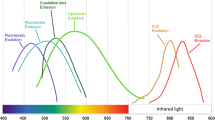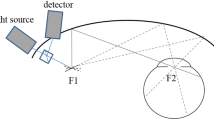Abstract
Fundus autofluorescence (FAF) imaging allows for topographic mapping of intrisnic fluorophores in the retinal pigment epithelial cell monolayer, as well as mapping of other fluorophores that may occur with disease in the outer retina and the sub-neurosensory space. FAF imaging provides information not obtainable with other imaging modalities. Near-infrared fundus autofluorescence images can also be obtained in vivo, and may be largely melanin-derived. FAF imaging has been shown to be useful in a wide spectrum of macular and retinal diseases. The scope of applications now includes identification of diseased RPE in macular/retinal diseases, elucidating pathophysiological mechanisms, identification of early disease stages, refined phenotyping, identification of prognostic markers for disease progression, monitoring disease progression in the context of both natural history and interventional therapeutic studies, and objective assessment of luteal pigment distribution and density as well as RPE melanin distribution. Here, we review the use of FAF imaging in various phenotypic manifestations of dry AMD.










Similar content being viewed by others
References
Schmitz-Valckenberg S, Holz FG, Bird AC, Spaide RF (2008) Fundus autofluorescence imaging: review and perspectives. Retina 28(3):385–409. doi:10.1097/IAE.0b013e318164a907
von Rückmann A, Fitzke FW, Bird AC (1995) Distribution of fundus autofluorescence with a scanning laser ophthalmoscope. Br J Ophthalmol 79(5):407–412
Delori FC, Dorey CK, Staurenghi G, Arend O, Goger DG, Weiter JJ (1995) In vivo fluorescence of the ocular fundus exhibits retinal pigment epithelium lipofuscin characteristics. Invest Ophthalmol Vis Sci 36(3):718–729
Kellner U, Kellner S, Weinitz S (2010) Fundus autofluorescence (488 NM) and near-infrared autofluorescence (787 NM) visualize different retinal pigment epithelium alterations in patients with age-related macular degeneration. Retina 30(1):6–15
Schatz H, McDonald HR (1989) Atrophic macular degeneration. Rate of spread of geographic atrophy and visual loss. Ophthalmology 96(10):1541–1551
Sunness JS, Rubin GS, Applegate CA, Bressler NM, Marsh MJ, Hawkins BS, Haselwood D (1997) Visual function abnormalities and prognosis in eyes with age-related geographic atrophy of the macula and good visual acuity. Ophthalmology 104(10):1677–1691
Klein R, Meuer SM, Knudtson MD, Klein BE (2008) The epidemiology of progression of pure geographic atrophy: the beaver dam eye study. Am J Ophthalmol 146(5):692–699. doi:10.1016/j.ajo.2008.05.050
Boulton M, Dayhaw-Barker P (2001) The role of the retinal pigment epithelium: topographical variation and ageing changes. Eye (Lond) 15(Pt 3):384–389. doi:10.1038/eye.2001.141
Schmitz-Valckenberg S, Steinberg JS, Fleckenstein M, Visvalingam S, Brinkmann CK, Holz FG (2010) Combined confocal scanning laser ophthalmoscopy and spectral-domain optical coherence tomography imaging of reticular drusen associated with age-related macular degeneration. Ophthalmology 117(6):1169–1176. doi:10.1016/j.ophtha.2009.10.044
Ferris FL 3rd, Wilkinson CP, Bird A, Chakravarthy U, Chew E, Csaky K, Sadda SR (2013) Clinical classification of age-related macular degeneration. Ophthalmology 120(4):844–851. doi:10.1016/j.ophtha.2012.10.036
Mimoun G, Soubrane G, Coscas G (1990) Macular drusen. J Fr Ophtalmol 13(10):511–530
Bindewald A, Bird AC, Dandekar SS, Dolar-Szczasny J, Dreyhaupt J, Fitzke FW, Einbock W, Holz FG, Jorzik JJ, Keilhauer C, Lois N, Mlynski J, Pauleikhoff D, Staurenghi G, Wolf S (2005) Classification of fundus autofluorescence patterns in early age-related macular disease. Invest Ophthalmol Vis Sci 46(9):3309–3314. doi:10.1167/iovs. 04-0430
Lois N, Owens SL, Coco R, Hopkins J, Fitzke FW, Bird AC (2002) Fundus autofluorescence in patients with age-related macular degeneration and high risk of visual loss. Am J Ophthalmol 133(3):341–349
Delori FC, Fleckner MR, Goger DG, Weiter JJ, Dorey CK (2000) Autofluorescence distribution associated with drusen in age-related macular degeneration. Invest Ophthalmol Vis Sci 41(2):496–504
Landa G, Rosen RB, Pilavas J, Garcia PM (2012) Drusen characteristics revealed by spectral-domain optical coherence tomography and their corresponding fundus autofluorescence appearance in dry age-related macular degeneration. Ophthalmic Res 47(2):81–86. doi:10.1159/000324988
Pilotto E, Guidolin F, Convento E, Spedicato L, Vujosevic S, Cavarzeran F, Midena E (2013) Fundus autofluorescence and microperimetry in progressing geographic atrophy secondary to age-related macular degeneration. Br J Ophthalmol 97(5):622–626. doi:10.1136/bjophthalmol-2012-302633
Toy BC, Krishnadev N, Indaram M, Cunningham D, Cukras CA, Chew EY, Wong WT (2013) Drusen regression is associated with local changes in fundus autofluorescence in intermediate age-related macular degeneration. Am J Ophthalmol 156(3):532–542 e531. doi:10.1016/j.ajo.2013.04.031
Klein R, Davis MD, Magli YL, Segal P, Klein BE, Hubbard L (1991) The Wisconsin age-related maculopathy grading system. Ophthalmology 98(7):1128–1134
Arnold JJ, Sarks SH, Killingsworth MC, Sarks JP (1995) Reticular pseudodrusen. A risk factor in age-related maculopathy. Retina 15(3):183–191
Smith RT, Sohrab MA, Busuioc M, Barile G (2009) Reticular macular disease. Am J Ophthalmol 148(5):733–743. doi:10.1016/j.ajo.2009.06.028
Zweifel SA, Spaide RF, Curcio CA, Malek G, Imamura Y (2010) Reticular pseudodrusen are subretinal drusenoid deposits. Ophthalmology 117(2):303–312. doi:10.1016/j.ophtha.2009.07.014
Schmitz-Valckenberg S, Alten F, Steinberg JS, Jaffe GJ, Fleckenstein M, Mukesh BN, Hohman TC, Holz FG (2011) Reticular drusen associated with geographic atrophy in age-related macular degeneration. Invest Ophthalmol Vis Sci 52(9):5009–5015. doi:10.1167/iovs. 11-7235
Finger RP, Wu Z, Luu CD, Kearney F, Ayton LN, Lucci LM, Hubbard WC, Hageman JL, Hageman GS, Guymer RH (2014) Reticular pseudodrusen: a risk factor for geographic atrophy in fellow eyes of individuals with unilateral choroidal neovascularization. Ophthalmology. doi:10.1016/j.ophtha.2013.12.034
Pumariega NM, Smith RT, Sohrab MA, Letien V, Souied EH (2011) A prospective study of reticular macular disease. Ophthalmology 118(8):1619–1625. doi:10.1016/j.ophtha.2011.01.029
Steinberg JS, Auge J, Jaffe GJ, Fleckenstein M, Holz FG, Schmitz-Valckenberg S (2013) Longitudinal analysis of reticular drusen associated with geographic atrophy in age-related macular degeneration. Invest Ophthalmol Vis Sci 54(6):4054–4060. doi:10.1167/iovs. 12-11538
Schmitz-Valckenberg S, Bultmann S, Dreyhaupt J, Bindewald A, Holz FG, Rohrschneider K (2004) Fundus autofluorescence and fundus perimetry in the junctional zone of geographic atrophy in patients with age-related macular degeneration. Invest Ophthalmol Vis Sci 45(12):4470–4476. doi:10.1167/iovs. 03-1311
Pilotto E, Benetti E, Convento E, Guidolin F, Longhin E, Parrozzani R, Midena E (2013) Microperimetry, fundus autofluorescence, and retinal layer changes in progressing geographic atrophy. Can J Ophthalmol 48(5):386–393. doi:10.1016/j.jcjo.2013.03.022
Fritsche LG, Fleckenstein M, Fiebig BS, Schmitz-Valckenberg S, Bindewald-Wittich A, Keilhauer CN, Renner AB, Mackensen F, Mössner A, Pauleikhoff D, Adrion C, Mansmann U, Scholl HP, Holz FG, Weber BH (2012) A subgroup of age-related macular degeneration is associated with mono-allelic sequence variants in the ABCA4 gene. Invest Ophthalmol Vis Sci 53(4):2112–2118. doi:10.1167/iovs. 11-8785
Zhou J, Jang YP, Kim SR, Sparrow JR (2006) Complement activation by photooxidation products of A2E, a lipofuscin constituent of the retinal pigment epithelium. Proc Natl Acad Sci U S A 103(44):16182–16187. doi:10.1073/pnas.0604255103
Bergmann M, Schutt F, Holz FG, Kopitz J (2004) Inhibition of the ATP-driven proton pump in RPE lysosomes by the major lipofuscin fluorophore A2-E may contribute to the pathogenesis of age-related macular degeneration. FASEB J 18(3):562–564. doi:10.1096/fj.03-0289fje
Schmitz-Valckenberg S, Brinkmann CK, Alten F, Herrmann P, Stratmann NK, Göbel AP, Fleckenstein M, Diller M, Jaffe GJ, Holz FG (2011) Semiautomated image processing method for identification and quantification of geographic atrophy in age-related macular degeneration. Invest Ophthalmol Vis Sci 52(10):7640–7646. doi:10.1167/iovs. 11-7457
Lindblad AS, Lloyd PC, Clemons TE, Gensler GR, Ferris FL 3rd, Klein ML, Armstrong JR (2009) Change in area of geographic atrophy in the Age-related Eye disease study: AREDS report number 26. Arch Ophthalmol 127(9):1168–1174. doi:10.1001/archophthalmol.2009.198
Csaky KG, Richman EA, Ferris FL 3rd (2008) Report from the NEI/FDA ophthalmic clinical trial design and endpoints symposium. Invest Ophthalmol Vis Sci 49(2):479–489. doi:10.1167/iovs. 07-1132
Holz FG, Bindewald-Wittich A, Fleckenstein M, Dreyhaupt J, Scholl HP, Schmitz-Valckenberg S (2007) Progression of geographic atrophy and impact of fundus autofluorescence patterns in age-related macular degeneration. Am J Ophthalmol 143(3):463–472. doi:10.1016/j.ajo.2006.11.041
Mauschitz MM, Fonseca S, Chang P, Göbel AP, Fleckenstein M, Jaffe GJ, Holz FG, Schmitz-Valckenberg S (2012) Topography of geographic atrophy in age-related macular degeneration. Invest Ophthalmol Vis Sci 53(8):4932–4939. doi:10.1167/iovs. 12-9711
Fleckenstein M, Schmitz-Valckenberg S, Lindner M, Bezatis A, Becker E, Fimmers R, Holz FG (2014) The “diffuse-trickling” fundus autofluorescence phenotype in geographic atrophy. Invest Ophthalmol Vis Sci. doi:10.1167/iovs. 13-13409
Fleckenstein M, Charbel Issa P, Helb HM, Schmitz-Valckenberg S, Finger RP, Scholl HP, Loeffler KU, Holz FG (2008) High-resolution spectral domain-OCT imaging in geographic atrophy associated with age-related macular degeneration. Invest Ophthalmol Vis Sci 49(9):4137–4144. doi:10.1167/iovs. 08-1967
Scholl HP, Fleckenstein M, Fritsche LG, Schmitz-Valckenberg S, Göbel A, Adrion C, Herold C, Keilhauer CN, Mackensen F, Mössner A, Pauleikhoff D, Weinberger AW, Mansmann U, Holz FG, Becker T, Weber BH (2009) CFH, C3 and ARMS2 are significant risk loci for susceptibility but not for disease progression of geographic atrophy due to AMD. PLoS ONE 4(10):e7418. doi:10.1371/journal.pone.0007418
Schmitz-Valckenberg S, Bindewald-Wittich A, Dolar-Szczasny J, Dreyhaupt J, Wolf S, Scholl HP, Holz FG (2006) Correlation between the area of increased autofluorescence surrounding geographic atrophy and disease progression in patients with AMD. Invest Ophthalmol Vis Sci 47(6):2648–2654. doi:10.1167/iovs. 05-0892
Bearelly S, Khanifar AA, Lederer DE, Lee JJ, Ghodasra JH, Stinnett SS, Cousins SW (2011) Use of fundus autofluorescence images to predict geographic atrophy progression. Retina 31(1):81–86. doi:10.1097/IAE.0b013e3181e0958b
Sunness JS, Margalit E, Srikumaran D, Applegate CA, Tian Y, Perry D, Hawkins BS, Bressler NM (2007) The long-term natural history of geographic atrophy from age-related macular degeneration: enlargement of atrophy and implications for interventional clinical trials. Ophthalmology 114(2):271–277. doi:10.1016/j.ophtha.2006.09.016
Fleckenstein M, Adrion C, Schmitz-Valckenberg S, Göbel AP, Bindewald-Wittich A, Scholl HP, Mansmann U, Holz FG (2010) Concordance of disease progression in bilateral geographic atrophy due to AMD. Invest Ophthalmol Vis Sci 51(2):637–642. doi:10.1167/iovs. 09-3547
Fleckenstein M, Schmitz-Valckenberg S, Adrion C, Visvalingam S, Göbel AP, Mössner A, von Strachwitz CN, Mackensen F, Pauleikhoff D, Wolf S, Mansmann U, Holz FG (2011) Progression of age-related geographic atrophy: role of the fellow eye. Invest Ophthalmol Vis Sci 52(9):6552–6557. doi:10.1167/iovs. 11-7298
Sunness JS, Bressler NM, Maguire MG (1995) Scanning laser ophthalmoscopic analysis of the pattern of visual loss in age-related geographic atrophy of the macula. Am J Ophthalmol 119(2):143–151
Sarks JP, Sarks SH, Killingsworth MC (1988) Evolution of geographic atrophy of the retinal pigment epithelium. Eye (Lond) 2(Pt 5):552–577. doi:10.1038/eye.1988.106
Sunness JS (1999) The natural history of geographic atrophy, the advanced atrophic form of age-related macular degeneration. Mol Vis 5:25
Forte R, Querques G, Querques L, Leveziel N, Benhamou N, Souied EH (2013) Multimodal evaluation of foveal sparing in patients with geographic atrophy due to age-related macular degeneration. Retina 33(3):482–489. doi:10.1097/IAE.0b013e318276e11e
Maguire P, Vine AK (1986) Geographic atrophy of the retinal pigment epithelium. Am J Ophthalmol 102(5):621–625
Sunness JS, Gonzalez-Baron J, Applegate CA, Bressler NM, Tian Y, Hawkins B, Barron Y, Bergman A (1999) Enlargement of atrophy and visual acuity loss in the geographic atrophy form of age-related macular degeneration. Ophthalmology 106(9):1768–1779. doi:10.1016/S0161-6420(99)90340-8
Schmitz-Valckenberg S, Fleckenstein M, Helb HM, Charbel Issa P, Scholl HP, Holz FG (2009) In vivo imaging of foveal sparing in geographic atrophy secondary to age-related macular degeneration. Invest Ophthalmol Vis Sci 50(8):3915–3921. doi:10.1167/iovs. 08-2484
Holz FG, Strauss EC, Schmitz-Valckenberg S, van Lookeren CM (2014) Geographic atrophy: clinical features and potential therapeutic approaches. Ophthalmology 121(5):1079–1091. doi:10.1016/j.ophtha.2013.11.023
Fleckenstein M, Wolf-Schnurrbusch U, Wolf S, von Strachwitz C, Holz FG, Schmitz-Valckenberg S (2010) Imaging diagnostics of geographic atrophy. Ophthalmologe 107(11):1007–1015. doi:10.1007/s00347-010-2159-y
Conflict of interest
Frank G. Holz is a consultant for Acucela, Alcon, Allergan, Bayer HealthCare, Genentech, Heidelberg Engineering, Novartis, and Roche. He has received research funding from Alcon, Allergan, Bayer, Genentech, Heidelberg Engineering, Novartis, Optos, Roche and Carl Zeiss MediTec.
Steffen Schmitz-Valckenberg is a consultant for Novartis. He has received research funding from Alcon, Allergan, Bayer, Genentech, Heidelberg Engineering, Merz Pharmaceuticals, Novartis, Optos, Roche and Carl Zeiss MediTec.
Monika Fleckenstein is a consultant for Roche/Genentech. She has received research funding from Genentech, Heidelberg Engineering, Novartis, and Optos.
Julia S. Steinberg has no conflict of interest to declare.
Arno Göbel has received research funding from Carl Zeiss MediTec, Heidelberg Engineering, and Optos.
Author information
Authors and Affiliations
Corresponding author
Rights and permissions
About this article
Cite this article
Holz, F.G., Steinberg, J.S., Göbel, A. et al. Fundus autofluorescence imaging in dry AMD: 2014 Jules Gonin lecture of the Retina Research Foundation. Graefes Arch Clin Exp Ophthalmol 253, 7–16 (2015). https://doi.org/10.1007/s00417-014-2858-1
Received:
Accepted:
Published:
Issue Date:
DOI: https://doi.org/10.1007/s00417-014-2858-1




